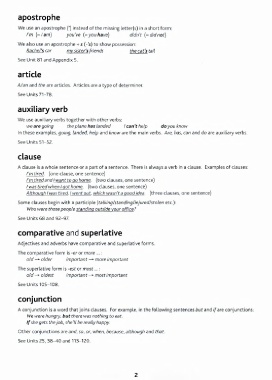Page 393 - murphy_raymond_english_grammar_in_use 1
P. 393
apostrophe
We use an apostrophe (') instead of the missing letter(s) in a short form;
I'm (=lam ) you've (=you have) didn't (= did not)
We also use an apostrophe + s (-'s) to show possession:
Rachel's car my sister's friends the cat's tail
See Unit 81 and Appendix 5,
article
A/an and the are articles. Articles are a type of determiner.
See Units 71-78.
auxiliary verb
We use auxiliary verbs together with other verbs:
we a re going the plane h a s landed I c a n 't help d o you know
In these examples, going, landed, help and know are the main verbs. Are, has, can and do are auxiliary verbs.
See Units 51-52.
clause
A clause is a whole sentence or a part of a sentence. There is always a verb in a clause. Examples of clauses:
I'm tired, (one clause, one sentence)
I'm tired and I want to go home, (two clauses, one sentence)
I was tired when I got home, (two clauses, one sentence)
Although I was tired, I went out, which wasn't a good idea. (three clauses, one sentence)
Some clauses begin with a participle (talking/standing/injured/stolen etc.):
Who were those people standing outside your office?
See Units 68 and 92-97.
comparative and superlative
Adjectives and adverbs have comparative and superlative forms.
The comparative form is -er or more ...:
old -» older important -> more important
The superlative form is -est or most... :
old —*■ oldest important —* most important
See Units 105-108.
conjunction
A conjunction is a word that joins clauses. For example, in the following sentences but and if are conjunctions:
We were hungry, b u t there was nothing to eat.
I f she gets the job, she'll be really happy.
Other conjunctions are and, so, or, when, because, although and that.
See Units 25, 38-40 and 113-120.
2

